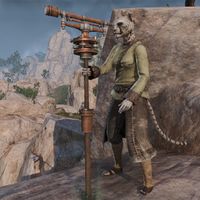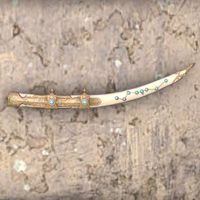Lore:Astronomy
Astronomy is the study of the Firmament, the sky above Nirn.
Contents
Celestial Objects[edit]
Sun[edit]
The sun (also known as Magnus, Daibethe in Yoku, Shul in the Dragon language, and Vakka in Jel) is the common term for the largest tear in reality between the Mundus and Aetherius. It appears as a bright orb in the skies of Nirn and is the main source of light and magicka in the world, providing a constant flow from Aetherius.
Meteors[edit]
Meteors, often called shooting stars, are fragments of celestial matter that fall from the sky. This occurs when a piece of Aetherius—the realm of spirits and the source of magic—becomes detached and descends to Nirn. They contain fragments, known as Aetherial Fragments renowned for their magical properties.
Moons[edit]
Moons are astronomical objects within Mundus. They are said to be small planets, though this comparison is only defined by mortal comprehension since, as with all astral bodies seen from Nirn, both the moons and dominion planets, they are truly infinite in size and mass, separate planes of existence that are only perceived as spheres due to mortal mental stress. Members of the Mages Guild described them as islands in the sky.
Nirn is generally thought to have two moons: Masser and Secunda. Masser is the larger of the two, being well over twice Secunda's size. According to the Khajiit, there is a third moon, which they consider the corpse of Lorkhaj. The Jonelight Path, a realm described as the place between places where the "liminal forces that bind each here to every there" can be accessed and from where any destination can be reached by those who can walk the path once the point where the "liminal of here touches the liminal of there" is reached , is named for the smaller of Nirn's two moons and is described as full of stars and moonlight
The dragon Kaalgrontiid once sought to absorb the energies of Jode's Core, the divine core of one of the moons, in the hopes of ascending to the sky as a New Moon and god who would be the equal of Akatosh
Planets[edit]
Planets are astronomical bodies. Altmeri high priests use jeweled rotating and counter-rotating orreries to determine which Aedric planet to worship. Number Eight is important in their culture as it is considered the Number of the Planets. They named planets after Elven Aedra, but refer to the same celestial objects as Mannish cultures.
The other astral bodies in the sky above Nirn, the moons and dominion planets, are believed to actually be the planes of the gods as well as the gods themselves, as seen from the mortal plane. They are said to actually be different planes of existence in their own right, infinite in size and mass, with their appearance as spheres being only a visual phenomena caused by mortal mental stress.
The largest shooting stars are actually planets with independent orbits. One of the most well-known is the Rogue Plane; Baan Dar.
Though scholars largely agree no mortal beings live on planets such as Akatosh or Arkay, Azandar al-Cybiades theorized that the power Ayleid Wells reroute back towards the heavens was being collected by someone.
Stars[edit]

Stars are astronomical objects believed by many to be tears in the veil of Oblivion that lead to Aetherius. There are a great many stars in the sky, some of which form the Constellations.
Altmer myths claim that stars were created by the Magna Ge, Anuic spirits that fled Creation after the departure of its architect, the god Magnus, who made the world. Magnus himself left the greatest tear in the firmament: the Sun, sometimes named Magnus. The stars are therefore sometimes referred to as the "children of Magnus". According to one Aldmeri myth and the creation tale of the Anuad, the stars were instead created from the blood of Anu. Some believe that stars are "fragments" of Magnus.
Within Bosmer belief Y'ffre is believed to have created day, night, and the places between through the manner in which he interpreted the laws of time established by Anui-El and applied them to Nirn, he is also believed to be responsible for the movements of the stars, as to this day the realms they're windows to sway and wink to his song. Dunmer faith also acknowledges Y'ffre in this capacity of being the deity responsible for the movements of the stars, which still sway to the beautiful song he sang when he walked Nirn before the first day.
Some stars are named after or associated with Daedric Princes or the Daedra in general. According to N'Gasta, the Daedra were born before the stars.
Redguards believe that the stars were created by Ruptga, who was so big he could place the stars themselves in the sky, as a way to guide spirits to the far shores. Their myths also describe how, after his death, the hunger of Sep, the Second Serpent, took form in the sky as a hungry void that chases and tries to devour the stars. Some sources claim that, before deceiving the spirits, Sep stole one of the stars which Ruptga held in his hand and was using to form the Great Map and put it in his pocket. When Sep was killed, it is this star that fell out of his mouth in the form of a pearl. The peal fell to the land and was covered by sand, and so came to belong to Zeht. It is said that this Pearl is the "Way and the Guide", the "light to the Far Shores and back again" and, when it is at last discovered again, water will flow over all the previous Worldskins and the time of Sep's Hunger will be over, the Hungry Stomach of Satakal at last sated. It is also said that the Hunger is what answers the call of the worlds to save them, and that the only real world is that of Satakal, as the stars can't be devoured.
The ancient Nedes believed the stars were set in their courses by the Great Dragon of Time, who also appointed the guardians to watch over them.
The Celestials are powerful ethereal beings formed by the power of the stars, the most powerful of which represent the Constellations. It is unknown if these beings are from Aetherius or if they are mortals who have achieved a state of ascension. Whatever the case, the Celestials that represent the constellations are linked to them, as in 2E 582 the corresponding stars temporarily vanished from the sky while the Celestials took form in Craglorn, and are said to be part of the world's natural order.
Unstars[edit]
Unstars, also known as not-stars, are celestial objects that resemble stars. Unlike stars, unstars move across the sky and do not emit varliance, though they still emit light. The nature of this light and its effect on mortals remains uncertain.
The constellation of the Serpent, comprised of four unstars, is not confined to appearing in the night sky at specific times of the year. The motions of unstars that form the Serpent are deemed unpredictable. Although they can be forecasted to some extent, sometimes it is deemed impossible.
Comets[edit]
Comets are celestial bodies characterized by their small size, composition of ice and dust, and the distinctive trails known as a comet's tail. They move through the heavens, and are often linked to significant events and frequently hold symbolic importance across various cultures and religions. They also are present in some magical practices.
Astronomical Phenomena[edit]
Constellations[edit]
Constellations (known as Sky Tales to the Reachmen) are collections of stars and other astronomical objects which appear in the night sky which form a perceived pattern. The constellation that is in the night sky at the time of year of a person's birth is called their birthsign (also spelled birth sign) or star sign and is believed to influence their characteristics and fate. Those born under certain constellations are said to be 'fortunate in their aspects'. Such people are often blessed or cursed with remarkable abilities or weaknesses as a result of the magical conjunctions of celestial influences.
There are generally accepted to be thirteen constellations in the sky, sometimes called the Thirteen Patrons. There are three guardian constellations, known to the Reachmen as the Reach Guardians and the Guardians in the Sky: the Warrior, the Mage, and the Thief, each associated with three other constellations, called their charges (known as the Lesser Stars to the Reachfolk). Each of these twelve constellations corresponds to one of the twelve months of the year. The thirteenth sign, the Serpent, is neither guardian nor charge.
Aurora[edit]
The aurora (also known as Kyne's lights) is a phenomenon occurring in the night sky characterized by vivid ribbons of light. It occurs when the skies are clear. Similar phenomena occur in realms of Oblivion, and Aetherius.
Bloodmoon[edit]
The Bloodmoon is a phenomenon occurring when Hircine's Great Hunt is hosted on Nirn. During the Great Hunt, Secunda turns a deep shade of red and becomes the Bloodmoon. The hunt is believed to end when the Bloodmoon disappears, and Secunda turning red is considered a calling for the chase. The Bloodmoon occurs naturally in the Hunting Grounds, as the Great Hunts are constantly held there.
Eclipse[edit]
Due to the two moons, solar eclipses can happen in Tamriel several times a year and are known as Vampire Days.[UOL 1]
Equinox[edit]
The Equinox is an astronomical phenomenon where day and night are nearly equal in length.
In Liminal Bridges, Camilonwe of Alinor discusses the significance of the equinox in magical practices. In this text, the equinox plays a crucial role in the ritual required to transform a morpholith into a sigil stone, an essential artifact for opening portals to Oblivion. The process involves preparing a purified chamber and placing the morpholith on a table at dawn during the equinox. The mechanic then performs uninterrupted rites from the Book of Law until sunset. The timing of the equinox is significant as it seems to enhance the ritual's effectiveness, allowing the morpholith to be prepared for inscription by a Daedra Lord, turning it into a sigil stone capable of sustaining powerful arcane energies.
According to one of the books in the Ancient Tales of the Dwemer series, The Snow Elf and the Variation-Lens, written by Gor Felim (under the alias of Marobar Sul), a so-called "dual equinox" is described as a real phenomenon. In this fictional account, Mzulchond, a Tonal Architect, spent twenty years tuning a great animus geode he discovered in Inner Duathand, attempting to synchronize it with the precession of these dual equinoxes to capture the elusive Nirnpith Essence. Despite being a poorly researched work posing as serious scholarship, Felim's texts influenced the perception of the Dwemer among the people of Tamriel, shaping popular beliefs and misconceptions about them.
Some pieces of equipment were named after the equinox phenomenon. In the late days of the Third Era, the Gauntlets of the Equinox, a pair of mithril gauntlets imbued with resistance to frost, were found in Cyrodiil.
Solstice[edit]
Solstice is an astronomical event that happens twice a year when the sun reaches its highest or lowest point in the sky at noon.
Winter Solstice[edit]
The winter solstice is the shortest day of the year, when the sun is at its lowest point in the sky. A number of beliefs and practices are linked to the Winter Solstice. The New Life Festival, observed on the 1st of Morning Star, celebrates the end of the old year and the start of the new, symbolizing hope and fresh beginnings. It also marks the Winter Solstice, when Magnus the Sun begins his return and the days start to lengthen. Each Tamrielic culture has its own traditions related to this event.
One legend surrounding the birth of Solstice Indriks claims that it originated from a child's toy, magically transformed on the year's longest night. However, other conflicting beliefs and stories also surround its mysterious birth.
Alduin, the Twilight God who ushers in the next cycle, was once venerated during the Winter Solstice through ceremonies held at ancient Dragon Cult temples. Offerings were made to keep him asleep for another year. Certain practices and rituals, meant to ensure his prolonged slumber, persisted long after the fall of the Dragon Cult, continuing into the Interregnum of the Second Era.
Some pieces of equipment were named after the winter solstice. In the late days of the Third Era, the Shield of Winter Solstice, an elven shield imbued with resistance to frost, was found in Cyrodiil.
Summer Solstice[edit]
The summer solstice is the longest day of the year, when the sun is at its highest point in the sky. The exact date of the summer solstice in the Tamrielic calendar is unclear. During this time, Masser shines brightly in the sky, and the constellation of the Steed becomes prominent in the southern sky. The Khajiiti clergy of Alkosh in Sunspire compare Jode to the intense heat and redness of the summer solstice.
Star Maps and Orreries[edit]
Many cultures follow the passage of the stars.
The Dwemer[edit]
Undoubtedly the most advanced knowledge of the heavens comes via the relics of the Dwemer.
Of particular importance is the Orrery found in the Arcane University at the Imperial City in Cyrodiil which shows all the various planets and can even draw upon the power of Nirn's twin moons.
A second place of importance is upon the island of Stros M'Kai where a Dwemer observatory lies. This observatory contains an orrery as well and a star chart upon its ceiling. The star chart displays runes for each constellation in a radial grid, clockwise by their associated month. A guardian and its three charges are all found at the same distance from the center of the galaxy.
The Reachfolk[edit]
The Reachmen call constellations "Sky Tales" and track them with visions and ancient Dwarven plaques. Some Reachfolk Witches can read the stars and see the future and hidden truths in their light.[1]
The Yokudans[edit]
The pre-Redguard Yokudan culture in particular was noted for its astrologers, who would make crude sand maps in their camps. These are identical to the Dwemer star charts in their radial configuration of the constellations. The only difference at all is the simplification of guardian runes to outlined squares and charge runes to filled circles.
The Elder Scrolls[edit]
Finally, the Elder Scrolls themselves would seem to depict some sort of star map, with various glyphs of unknown purpose adorning both the foreground and background. Those with no knowledge of the Elder Scrolls, or those with special destinies, can view an Elder Scroll with no ill-effects, and report to see in them patterns similar to star charts, at least those familiar with astronomy or astral navigation.[2]
Upon careful examination of the particular Elder Scroll depicted here, one can see an outline of The Thief constellation; this is highly appropriate, as this particular Elder Scroll was stolen from the Imperial Palace and used to break the curse on the Cowl of Nocturnal.[3]
Gallery[edit]
References[edit]
- ^ Arana's dialogue in ESO
- ^ Effects of the Elder Scrolls — Justinius Poluhnius
- ^ The Ultimate Heist quest in Oblivion
Note: The following references are considered to be unofficial sources. They are included to round off this article and may not be authoritative or conclusive.
























